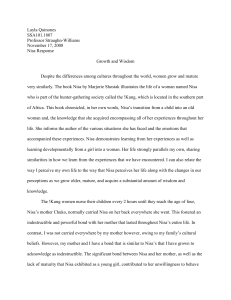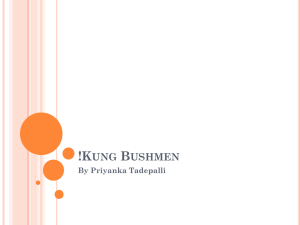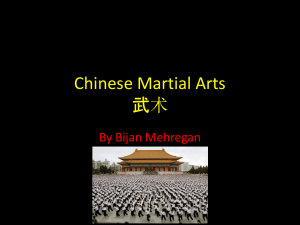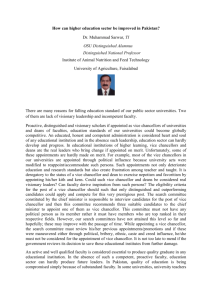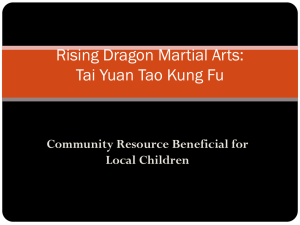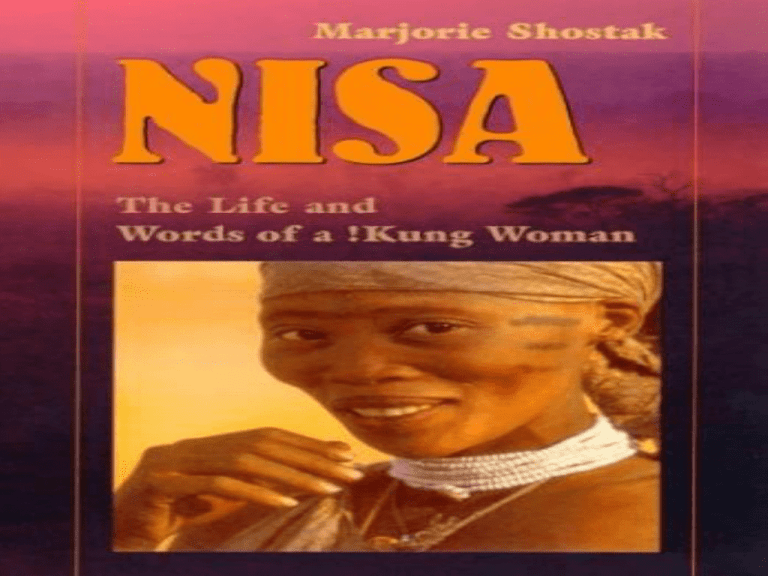
Nisa: The Life and Words of a !Kung
Woman
Majorie Shostak
Chapter 9: Kinship & Descent
[p 262-285]
•Ethnography: descriptive research study designed to explore in
cultural phenomena or the recording of human cultures
•Overview/Key Facts:
•Setting (time & place): village of !Kung bushmen or “Zhun/twasi” as
they call themselves; northern edge of Kalahari Desert, Bostwana
•Begins in 1969, lasts for two years. Resumes during Shostak 2nd visit in
1975.
•Recorded interviews/meetings with Nisa [a !Kung woman] about her life
experiences
•Book is divided into 15 chapters, each opens with a present tense
introduction by Shostak and then goes into a past tense story telling by
Nisa
Map of Bostwana- Northern
Kalahari Desert
Assigned Work for Next Class
Read Introduction AND chapter 1-4 in Nisa
Read pages 262-264 in textbook ONLY the
following sub-headings:
Intro
Why We Study Kinship?
Urban Kinship Systems in Canada
Descent Groups
Task- Due Next Class
Pick a part in Nisa’s story from these
chapters(1-4) that resonates with you.
Quote it in a journal entry and explain
why you chose it. Then, briefly (in one
paragraph) anaylze the quote in terms of
its’ significance.
How does this explain any of the following:
Socialization, status and role
Gender and sexuality, public/private life
Social group, identity (ethnicity, race, nationality,
class and religious identity)
Chapter 1-4 Brief Summaries
Chapter 1
Nisa describes early memories of her childhood
and her pregnant mother
Helps in the delivery of her younger brother,
Kumsa
Vivid memorial descriptions of her mother
wanting to kill Kumsa because she did not
want to stop nursing Nisa
Does not actually kill him
Was nursed and brought up by Aunt,
Grandmother, Father and Mother; expresses
failure of their upbringing as she considers
herself physically small and unfit.
Chapter 1-4 Brief Summaries
Chapter 2
Recalls growing up with her brother, fighting
with him, playing with him, protecting him
from harm and experiencing sibling hatred
Anger as a common form of expression in !Kung
children, though they are discouraged from fighting
Growing family: remembers mother’s
pregnancy with her fourth child
Develops understanding of female
menstruation, bearing children and giving birth
Chapter 1-4 Brief Summaries
Chapter 3
Describes life of hunter-gatherer in Kalahari
Desert
The act of hunting prey and celebration of
meat in the village
Experiencing harsh, dry climate [drought] and
having to eat bugs such as caterpillars in order
to survive
Experiencing hunger and thirst in periods of no rain
Asks herself if she was ever happy as a child
Chapter 1-4 Summaries
Chapter 4
Nisa remembers what it is like to engage in
sex play with other children of the village
Recalls sexual aggression from some boys and girls
First young boys would practice sex play with each
other and then move onto practicing it with young
girls
Parents did not approve of this
Notes that there was a reason as to why
parents and children, all slept in the same hut
Explains that it was because children could eventually
see and learn what parents were doing under the
blanket
Task –Due Next Class
Read Nisa Chapters 5-7
Also read pages 264 (Descent Groups and on) to
page 270 in the textbook
Pick a part in Nisa’s story from these chapters(5-7)
that resonates with you. Quote it in a journal entry
and explain why you chose it. Then, briefly (in one
paragraph) anaylze the quote in terms of its’
significance
Ritual (rites of passage, rites of revitalization)
Resistance
Family Household and Marriage
Rights of Property
Power, authority and leadership
Questions to Consider
Reflect and answer the following questions. This
can be done in small groups and should be
handed in at the end of the class:
What is the role of a !Kung woman? What is the role of a
!Kung man?
Thinking about the definition of kin and kinship, would
you define the village people as Nisa’s Kin or only her
immediate family as kin? Why or why not?
Explain how the model of extended family can be
applied to the network seen in Nisa’s village.
What private events become public in Nisa? And does
this change your perspective on what is public and what
is private? Think about what is deemed private and
public in Canadian society and in your own culture and
compare it to !Kung society.
Chapter 5-7 Summaries
Chapter 5
Nisa explains concept of ‘trail marriages’
through her first two marriages; one with a
man named Bo and another man named Tsaa.
Married to both men at very young age, Nisa
describes her difficulty and lack of
comfortability as they being to desire her
sexually.
Nisa also speaks about her love for a married
man named Kantla, who asks Nisa to marry
her as ‘co-wife’, but she refuses.
Chapter 5-7 Summaries
Chapter 6
Nisa explains how menstruation and marriage
are most important passages in a !Kung
woman’s life
She enters first long marriage with a man
named Tashay
Early in the marriage, Nisa experiences her
first menstruation period
This is followed by a series of rituals performed
in a closed hut by the women in the village
Song and dance are seen as important part of
these rituals
Chapter 5-7 Summaries
Chapter 7
Concerned with the common practice of
adopting a co-wife
After much resistance, Nisa gives Tashay
permission to bring a co-wife
Nisa explains her experience when Tashay
brings a co-wife named Tiknay
She is jealous and during the year that Tiknay
stays with Tashay and Nisa, Nisa refuses to let
Tashay near herself
Courtship and Dating Practices
Among !Kung Society
Average age of marriage is between 12-16
years of age
Mother of boy must approach mother of
girl in order to propose marriage
If approved, traditional engagement
ceremony takes place and wedding is
secured through the exchanging of gifts,
known as “Kamasi” ritual
Courtship and Dating Practices
Among !Kung Society (Cont.)
Parents expected to pay close attention to
kinship and name relations of their
potential candidates
Not allowed to marry immediate family
members (daughters forbidden to marry
fathers and sons forbidden to marry
mothers)
Not allowed to marry first cousins
Girls not allowed to marry someone who
shares name with father or brother (s)
Courtship and Dating Practices
Among !Kung Society (Cont.)
Parents look for certain qualities when
choosing a man fit for their daughter
Good hunter
Cannot be known as a ‘fighter’
Must continue to exchange gifts (Kamasi
ritual) and if discontinues, can be seen as an
unfit suitor
Traditional Wedding Ceremony
Ritual begins by ‘mock force carry’ of bride
from parents hut to groom’s hut
Struggle or resistance put up by Brides
family is part of ceremonial ritual
Explores underlying conflict between husband
and wife and also parent and child, as girl
usually gets no say in marriage
Can be seen as reluctance to marriage
Also explores correlation between sexual
arousal and violence
Brides and grooms are rubbed or sprayed
with aromatic oils and powders
TASK: Legalities of Marriage
There is no formal legal system for
marriage and divorce.
In groups of 2-3 discuss the implications of this. Without
any legal authority, do you think that marriage and divorce
can be taken seriously? Based on your reading of Nisa up
till now, does there need to be a legal system for marriage
and divorce? Or, do you think that the community acts as
legal conveyors? Furthermore, thinking about the definition
of a descent group, how does the absence of legal
authority change membership(s) of people within in certain
clans and how does this affect parent-child links?
Please submit a 1-2 paragraph response by the end of
class.
Task- Due Next Class
Read Nisa Chapters 8-10
Also read pages 271-276 (ONLY UP
TO “THE DESCENT GROUP”)
Pick a part in Nisa’s story from these chapters(8-10) that
resonates with you. Quote it in a journal entry and explain
why you chose it. Then, briefly (in one paragraph) anaylze
the quote in terms of its’ significance
Rituals
relationships and environment
Forms of expression
Suffering
Descent and lineage
ALSO THERE WILL BE A SHORT ANSWER QUIZ
ON CHAPTER 1-10
Chapter Summaries 8-10
Chapter 8: First Birth
Nisa becomes pregnant with her first child
Her husband questions the paternity of the
child, as Nisa is known to have multiple sexual
partners, prior to the pregnancy
Nisa gives birth to a baby girl; names her
Chuko, who later dies in infancy
She describes the pain of losing her child more
painful than giving birth.
At the end of the chapter, Nisa is pregnant
again with another child
Chapter Summaries 8-10
Chapter 9: Motherhood and Loss
Nisa gives birth to her second child Nai, all by herself
among some roots and cuts the umbilical cord herself
Becomes pregnant with third child but miscarries
After she miscarries, her husband Tashay leaves and
she becomes close lovers with Twi again
Nisa becomes pregnant again and Tashay who
returns after a month, is furious
Makes herself miscarry with the child that she has
with Twi to make Tashay happy
Has another girl, Bau, who dies about a year later
Has a boy, names Kxau
Nisa’s husband dies and she returns to live at her
parent’s hut
Chapter Summaries 8-10
Chapter 10: Change
The !Kung environment begins to change as settlements
of different cattle-herding groups begin to call the
Kalahari Desert their home.
These groups are known as the Tswana and Herero
Nisa’s cousin’s husband asks her to be his co-wife; Nisa
refuses
Nisa builds her own hut and after refusing to marry
Besa, she allows him to enter her hut and becomes his
lover
Nisa is still in love with Kantla and wants to marry him
but, Kantla wants Nisa as a co-wife, which Nisa refuses
Also has a lover affair with Tsaa and other men during
this time
Chapter 1-10 Quiz [out of 15]
Why does Nisa think that she is physically small and unfit? (1 mark)
What did Nisa and other !Kung people of the village eat during the period
of drought? (1 mark)
Name two ways in which !Kung children learned or practiced sex. (1 mark)
Define the model of extended family and explain its’ significance to Nisa.
(2 marks)
What are the names of Nisa’s first two husbands from her trial marriages?
(1 mark)
Who is Nisa is in love with at the time of her second trail marriage? (1
mark)
Name an important rite of passage in a !Kung woman’s life. (1 mark)
Name one ritual performed at a !Kung girl’s first menstruation. (1 mark)
What is a co-wife and how does this relate to the term polygamy? (2
marks)
Name two qualities that !Kung parents consider when choosing a man for
their daughter. (1 mark)
How many children does Nisa have by the end of Chapter 10? (1 mark)
After which child does Nisa’s husband Tashay die? (1 mark)
Why does Nisa refuse to marry Besa? (1 mark)
Task: Due Next Class
Read Nisa Chapters 11-13
Also read pages 276-279 (ONLY UP
TO “KINSHIP TERMINOLOGY AND
KINSHIP GROUS”)
Pick a part in Nisa’s story from these chapters(11-13) that
resonates with you. Quote it in a journal entry and explain
why you chose it. Then, briefly (in one paragraph) anaylze
the quote in terms of its’ significance
Purity and impurity
Honour and shame
Relationships and environment
Gender roles
Suffering and rituals
Chapter Summaries 11-13
Chapter 11: Women and Men
Besa and Nisa moved to the East, where Besa finds
work with a Tswana cattle herder
Nisa’s father dies and Nisa goes back to her
family’s village to visit
Soon after, her mother dies despite her brother’s
healing powers
Before moving back to the East, Nisa and Besa visit
Besa’s family and Nisa becomes very ill
Her brother Dau heals her and she returns to the
East to work in the home of a European woman
Nisa believes Besa has ruined her because she
miscarries the one child she has with him
Chapter Summaries 11-13
Chapter 12: Taking Lovers
Nisa speaks about all her lovers and maintains
that one man can give a woman very little and
thus, she should have many sexual partners
She recalls her childhood and seeing her
mother with her lover and then telling her
father about her mother’s affair
Sex is a major theme and is seen to have
commonplace in the !Kung society. It is openly
accepted and discussed, especially among
!Kung women
Chapter Summaries 11-13
Chapter 13: A Healing Ritual
Nisa explains the !Kung people’s reliance on
worldly spirits
Explains the important role these spirits play in
healing illnesses
She goes in depth in explaining the healing
powers of her father and brother
She also recalls the time that her mother
taught her how to go into a trance and learn to
heal herself
Task: DUE NEXT CLASS
Read Nisa Chapters 14 and 15
Also read pages 279-284 (end of
chapter)
Pick a part in Nisa’s story from these chapters(14-15) that
resonates with you. Quote it in a journal entry and explain
why you chose it. Then, briefly (in one paragraph) anaylze
the quote in terms of its’ significance
Status and role
Religious/spiritual identity
Modernity and colonialism
Parenthood
Division of labour
Relationships with environment
ALSO NEXT CLASS, THERE WILL BE A FINAL QUIZ
Formal Debate
the class will be split up into two. One side
will represent the affirmative side and the
other, the negative side.
With your group, discuss the following and
be ready to present it in a formal debate in
the last 15-20 minutes of class!
Multiple sexual partners is what allows !Kung
women to have power and control. Agree or
disagree in terms of gender roles and power
relations
Chapter Summaries 14-15
Chapter 14: Further Losses
We learn that Nisa’s two children Nai and Kxau die in
their early adolescent years
Nisa goes into detail about Nai’s abusive relationship
with her husband that eventually is the reason for her
death
Nisa complains about this to Tswana headman and then
a tribal hearing takes place
Nisa also explains the cause of her son’s death: honey
that was partially eaten by a badge and spread a virus
in his chest
Nisa ends up taking care of and raising her brother’s
daughter, Nukha.
Emphasis on the power of God
Chapter Summaries 14-15
Chapter 15: Growing Older
Continued emphasis on the power of God anda ability to
control human births and deaths
Nisa, now in her old age, constantly dreams about being
pregnant and having children
Expresses her continual interest in sex despite her age
and her need for multiple partners
She does express feeling ugly due to her age and due to
the fact that Bo (her husband at the time) does not want
to sleep with her
Expresses sincere desire for children; wants to be able
to have children and even asks Shostak for medicine
that will allow her to do so.
Epilogue
Shostak describes her journey, going back
Dobe in 1975
She and her husband, along with a
graduate student conduct a study on a
women’s menstrual cycle
Near the end, she meets with Nisa again
and confirms that she is happy and
healthy.
She asks Nisa to publish the interviews as
a book and Nisa agrees
Quiz: Chapters 11-15
To where to Nisa and Besa move and why? (1 mark)
Nisa believes that _______ gives women power and control
(1 mark)
Why are the spirits so important for the !Kung people? (1
mark)
Who teaches Nisa to go into a trance and practice healing?
(1 mark)
Who heals Nisa when she is ill? (1 mark)
What common ritual is practiced during the healing
process? (1 mark)
Besa leaves Nisa for quite some time and in that period,
who does Nisa begin to live with? (1 mark)
What man is Nisa presently with? (1 mark)
How does Nisa’s daughter, Nai die and he son, Kxau die?
(2 marks)
What To Look For: (The Gods Must
Be Crazy
Attitudes towards different traditional and
religious practices
How did egalitarian practices get
introduced?
Power dynamics in traditional !Kung
society
Social activities and types of music
Introduction of outside influences
(technology, transportation etc) and how
technology changes all of the above

